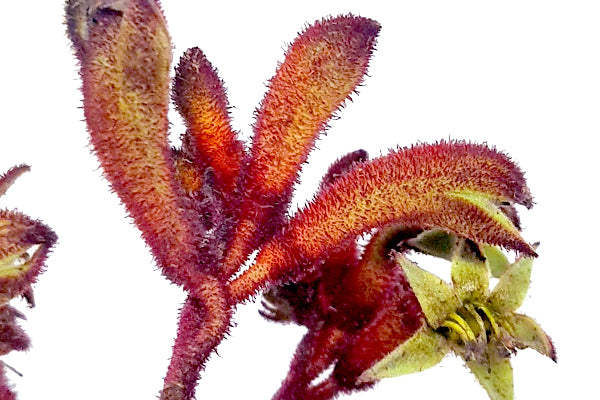
The Kangaroo Paw is known for its unique appearance so it’s no surprise that this bloom stands for individuality – making it the perfect gift for someone who’s free-spirited and not afraid to speak their mind. In this article, we’ll cover everything about this plant from the Land Down Under. From the do’s and don’ts of gifting Kangaroo Paws to symbolisms and history. So sit tight, get a cup of tea and enjoy this read!
KANGAROO PAW:
WHAT DO THEY MEAN & WHEN TO GIFT
Boasting fuzzy petals that are shaped like an animal’s paw, this unusual flower is a symbol of uniqueness and individuality. Though it’s probably not everyone’s first choice for some occasions, these quirky flowers are great fillers for floral arrangements! So if you know someone who has recently picked up a new hobby in floral design, this is the perfect gift for them. They also come in a range of colours: White, yellow, green, orange, pink, red, purple!
IMPORTANT GIFTING NOTES FOR KANGAROO PAW

Kangaroo Paw For Gifting: Do's
- If you’re looking for a flower that’s suitable for someone with allergies, look no further! Kangaroo Paws are known for their low pollen count, making them a popular bloom for bouquets.
- The Kangaroo Paw plant is pet-friendly, so no qualms about that!

Kangaroo Paw For Gifting: Don'ts
- Under the right conditions, Kangaroo Paws are susceptible to ‘ink disease’ whereby fungus causes black blotches to appear on the leaves.
- Apart from ink disease, Kangaroo Paws are also vulnerable to other fungal diseases like root rot. If you know someone who’s sensitive to mold, this might not be the right gift for them.
- Those with sensitive skin may face irritation from the hairy flowers.
KANGAROO PAW FLOWER CARE 101
Kangaroo Paws surprisingly thrive on a good cutting back once the flowering is complete at the end of summer or in early autumn! However, they’re difficult plants to grow and are considered short-lived flowers. Once these blooms are cut, there are still some special steps you need to take for them to last longer in your vase. Here are some pro-tips you can refer to if you’ve just received a bunch with Kangaroo Paws!

Basic Care Steps For Cut Kangaroo Paws
- After unwrapping your bunch, remove all foliage that is below the water level.
- Pop them into a clean vase with fresh room-temperature water.
- Need more tips? Read our Flower Care Guide for more information.
Pro-Tips for Kangaroo Paw Flower Care
- To reduce the risk of air pockets forming at the base of the stems, you can trim them under water
- Keep the flowers out of direct sunlight, and as cool as possible without freezing.

KANGAROO PAW: A HISTORY
They have been known as ‘Kangaroo Paws’ since the 1850s – but were originally called a ‘Kangaroo Foot’! Native to Western Australia, the Kangaroo Paw belongs to the genus Anigozanthos. Angio in Greek means to expand, while anthos means flower. As its name suggests, this is a reference to the way the flowers split! They were also initially known as ‘Kangaroo Foot’ before they were known as ‘Kangaroo Paws’ in the 1850s!
Anigozanthos was first described by Jacques-Julien Houtou de Labillardière, a French biologist, in 1798 when he was onboard the Espérance during its expedition to Australia. You can find these exotic blooms in… surprise, surprise, Australia – more specifically, south-west of Kalbarri to east of Esperance!
DID YOU KNOW?
Kangaroo Paw plants produce diluted nectar that doesn’t attract bees! Bees are also highly likely to avoid your Kangaroo Paws if they’re red, since they don’t distinguish shades of that colour. This trait is beneficial especially for those who are allergic to these flying pollinators.
KANGAROO PAW VARIETIES
There are currently 11 species and 13 identified subspecies, most of which are easily distinguishable by the colours of the flower-heads. The most well-known and famous paws are
Anigozanthos Manglesii
(Red and Green Kangaroo Paw)
- Red and green flowers supported by a red stalk that can grow up to 1 m
- Flowers around July- Nov
- Western Australia’s official floral emblem
- No scent
Anigozanthos Rufus
(Red Kangaroo Paw)
- Red flowers
- Flowers around Sept – Dec
- This was the first Anigozanthos species to ever be described
- No scent
Anigozanthos Humilis
(Catspaw)
- Yellow, red and orange flowers
- Flowers around July-Nov
- The most widespread species
- No scent
A PAW-ESOME CONCLUSION
With a one-of-a-kind flower shape, it’s no wonder the Kangaroo Paw stands for individuality. Whether it’s for someone who’s free-spirited or eccentric, the Kangaroo Paw can be combined with other vivid blooms to symbolise unique love or unique friendship! Those who have pets at home or are allergic to bees, this one’s for you!










